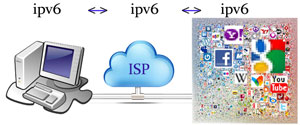../guides
IPv6 adoption strategy
CIS's Data Centre in the UK (Custodian) is DualStack IPv4 and IPv6 capable.
We have also published an example of how we've configured a Small Office / Home Office (SOHO) environment for Dual Stack.
The business case for IPv6 adoption
IPv4 address space exhaustion is the most compelling reason to consider a move to IPv6. IP addresses are assigned first globally and then geographically in ever smaller sub-allocations. From the quote below, the global pool ran out in 2011. A number of regions have also run out. See the IPv4 Exhausion Counter on the right.

The top-level exhaustion occurred on 31 January 2011.[1][2][3] Three of the five RIRs have exhausted allocation of all the blocks they have not reserved for IPv6 transition; this occurred on 15 April 2011 for the Asia-Pacific,[4][5][6] on 14 September 2012 for Europe, and on 10 June 2014 for Latin America and the Caribbean.

When there are no more IPv4 addresses left to allocate new content will only be provided to the IPv6 internet. IPv4 only consumers will be reliant on gateways to access this content.
New internet users will be allocated only IPv6 addresses, they will be able to access IPv6 content without an issue, but they will need to use tunnels or gateways to access IPv4 content.
The use of gateways and tunnels for access between IPv4 and IPv6 carries risk of performance loss through latency and congestion - public gateways/tunnels have no SLAs where as private gateway/tunnels will incurr costs.
Since the work to move to IPv6 is inevitable CIS's advice is to plan and start work on enabling IPv6 now to avoid any reliance on gateways / tunnels.
Risk
IPv6 removes the need for Network Address Translation (NAT). NAT has a firewalling side effect, which some have come to rely on.
Organisational Border Control needs to actively protect internal services once IPv6 is enabled (to make up for the loss of NATs passive protection).
This will be a non issue for any good firewalling product/design/device, but it should be an item on the project checklist.
How to go about this?
There are 3 recognised mechanisms for IPv6 adoption :-
- Dual IP stack implementation
- Tunneling
- Proxying and translation for IPv6-only hosts
Dual stack implementation is the only one that will not require another non-trivial change again in the future. It results in both IPv4 and IPv6 addresses being accessible from networked devices at the same time. Once set up this will likely remain in place for next 5-15 years, until all the content on the IPv4 internet is natively available on the IPv6 internet.
The entire channel must become IPv6 enabled: providers and consumers of content and the ISP/IAP channel must all be enabled.

What can I do now?
Everyone is a consumer and if you have a website you are a provider of content. If you operate a network at home or at work you are part of the channel.
- As a consumer:
Talk to your network provider / PC support and ask them to ensure that when you follow the link http://test-ipv6.com you see a 10/10 for readiness.
- As a provider of content:
Ensure that your content is reachable over the IPv6 internet. If it isn't you will be reliant on gateways to deliver your content to IPv6 consumers. If CIS is your hosting company contact us to begin a conversation. We have one fully routed Dual stack IPv6 office we can test access from.
- As a network channel:
If you're a small business see our IPv6 implementation example. If you're larger than that and don't already have a plan contact us to begin a conversation, we might be able to help.
IPv6 - It will matter to you.
Check your readiness - http://test-ipv6.com
The worlds top 3 internet sites Google, YouTube and Facebook are all already IPv6 capable using the DualStack solution.
How big is IPv6?
People have made some ingenious attempts to visualise the size difference between IPv4 and IPv6.
IPv6 addresses are made up of 128bits, vs 32bits for IPv4. The address below is a typical 128bit ipv6 address grouped in 8 chunks of 16bits each. The extent of the IPv4 internet is represented in just the last 2 16bit chunks:
2001:0db8:0000:0000:0000:0000:0000:0000
Once you try to imagine that 4 billion IPv4 internets still only consume the lower 4 16bit chunks the futility of continuing the comparison becomes obvious.
The number is simply unpronounceable.
Further reading:

 Take a look at our QR code, if you hover over it you can scan our full VCard.
Take a look at our QR code, if you hover over it you can scan our full VCard.